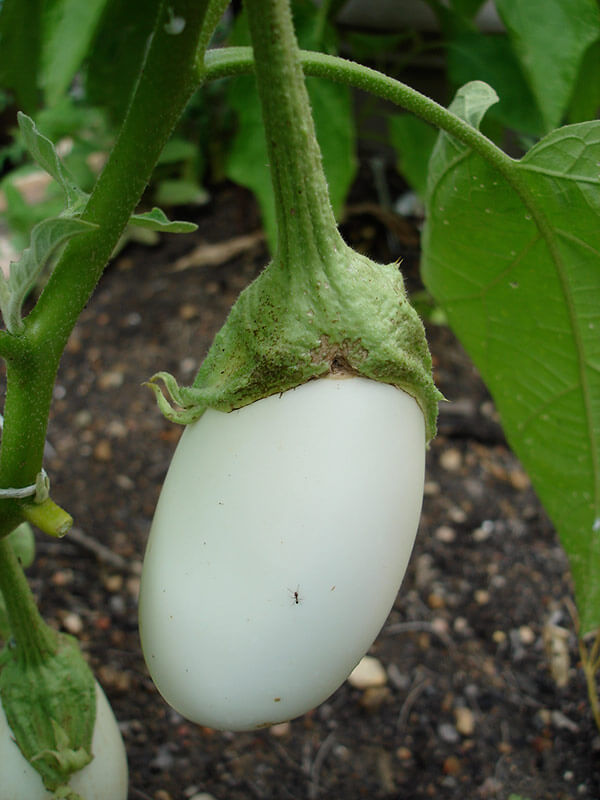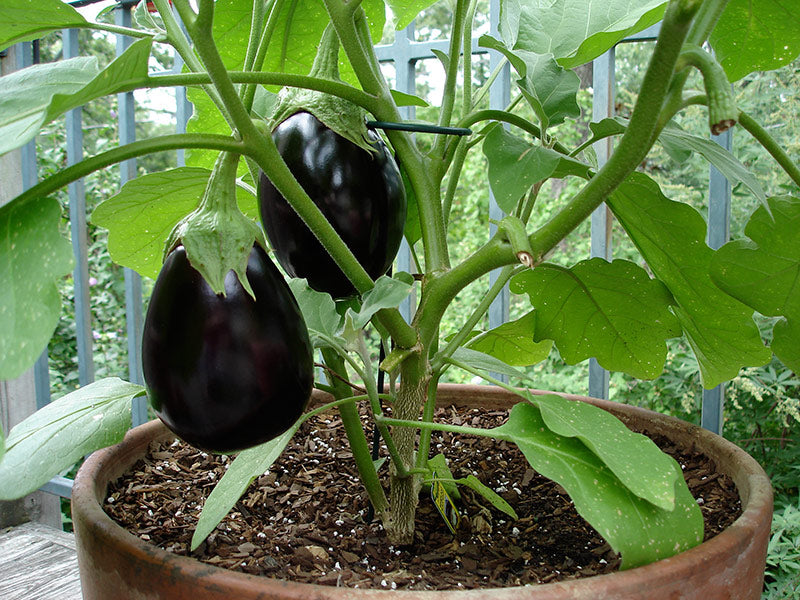Growing eggplant is a must if you're a fan of outdoor grilling! These stately plants grow well and look beautiful in containers, ornamental borders, raised beds, and traditional in-ground gardens.
Small-fruited varieties tend to be especially heavy bearers, and you can expect to pick a dozen or more from each Ichiban plant over the summer in warm climates. Larger varieties like Black Beauty and White, which bear more traditional-sized fruits, are equally impressive whether in the garden or kitchen, where they can be stuffed, grilled, or combined with summer herbs and tomatoes in homemade eggplant parmesan. Whichever kind of eggplant you prefer, be sure to choose strong young Bonnie Plants® eggplant to get you off to a good start.
Quick Guide to Growing Eggplant
- Plant eggplant when soil temps are above 50° F and all chances of frost have passed.
- Space eggplant 24 to 36 inches apart and stake them once established to prevent toppling. Choose an area with abundant sunlight and fertile, well-drained soil.
- Improve native soil by mixing in several inches of aged compost or other rich organic matter.
- Keep soil moist but not soggy—soaker hoses are a great option.
- Keep your plants fed by feeding them regularly with a continuous-release plant food.
- Apply a layer of mulch made from organic matter, such as finely ground leaves or bark, once plants reach 6 inches tall.
- Harvest eggplant when fruits stop growing and their skin becomes glossy. Remove ripe fruit with gardening shears, leaving a small portion of the stem attached.
Soil, Planting, and Care
Eggplant loves warmth and grows best in very sunny, well-drained locations. Raised beds that have been filled with 100 percent organic Miracle-Gro® Raised Bed Soil (which is just the right weight and texture for optimum root growth) or in-ground in soil that has been generously enriched with composted manure or aged compost-enriched Miracle-Gro® Performance Organics®All Purpose In-Ground Soil are ideal. When growing in pots, fill them with Miracle-Gro® Performance Organics® All Purpose Container Mix, which also contains nutrient-filled compost.
Although their coarse, leathery leaves withstand hot weather in champion style, eggplants benefit from a generous mulch of hay, shredded leaves, or other biodegradable material beneath plants to keep the soil relatively cool and to hold moisture and keep down weeds. Because eggplant really needs warm soil to grow well, gardeners in cool climates often do best growing the plants in large, dark-colored containers. On a sunny day, soil temperatures inside black pots may be 10 degrees or more higher than in-ground soil temperatures. Row covers are also a good option in cool climates, or even to protect plants from cool spells in warm climates. Open the ends of the row covers on warm days to let the bees reach the flowers for help with pollination.
Eggplants grow into tall, angular plants, so they should be spaced 24 to 36 inches apart. Improve planting holes by mixing in 2 inches of compost to help hold moisture and fertilizer in the soil. Set plants at the same depth at which they are growing in their containers, and water well before spreading mulch. To help keep plants strong and well fed, fertilize them regularly with Miracle-Gro® Performance Organics® Edibles Plant Nutrition Granules, following label directions. Combining great soil with premium plant food is a surefire way to have lots of success growing eggplants.
In the case of a late cold spell, you may need to delay planting seedlings until cool weather passes. Should this happen, keep the plants in a sheltered, sunny spot outdoors during the day, and bring them indoors at night.
Be sure to keep plants watered or they will be small and bitter. They need a nice, steady supply of moisture but not so much that the soil is soggy. Drip systems or a soaker hose are ideal.
Eggplants are prone to falling over when loaded with fruit, so you may want to tie plants to stakes to keep them upright. If you drive a stake into the ground just an inch or two from the plant at the time of planting, you won't disturb the plant by trying to do it later. You can also use small tomato cages to support the plants.
Troubleshooting
The tiny, black flea beetle is by far the worst nemesis of eggplant, but big, healthy plants usually produce well despite tiny leaf holes made by lots of flea beetles. In some areas, a common soil-borne fungus, verticillium wilt, can cause lants to wilt and die. Where verticillium is a common problem with non-resistant tomatoes (they are close eggplant cousins), grow eggplants in containers filled with premium potting mix.
Harvest and Storage
Fruits can taste bitter if picked when underripe or overripe, so harvesting is part of the eggplant grower's art. A perfect fruit will stop growing larger, have a glossy skin, and show a sprinkling of soft, well-formed yet immature seeds when you slice it open. Fruits with no visible seeds are immature, and hard, dark seeds are found in overripe eggplants. Use pruning shears to harvest fruit with a short stub of stem attached, because the fruits will not pull free by hand. Rinse clean, pat dry, and store in the refrigerator for several days. Eggplant discolors rapidly when cut open, so work quickly when preparing slices or skewers for grilling. Marinades that include salt, vinegar, and/or lemon juice will keep cut pieces from darkening.




FAQs
Where should I plant my eggplant?
This plant despises cold, wet weather. It grows best in warm or hot weather and a very sunny garden. In cool mountain climates, you may need a greenhouse. Some varieties, like Ichiban, do exceptionally well in containers.
Does eggplant grow upright or is it supposed to fall into a vine and grow on the ground?
It grows upright on a shrubby plant, but the fruit can get so heavy that it pulls the plant down. Use a plant stake or cage to hold the plants upright.
Can Ichiban eggplant be grown in a container?
It is great for a container. Plant each plant in a five-gallon or larger pot in full sun.
Does my container-grown eggplant need to be outdoors for pollination?
Yes, it needs to be outdoors for bright sunlight and because bees are needed for good pollination.
What causes eggplant fruit to become distorted and strangely colored?
Very high temperatures and low moisture give rise to poor-quality, misshapen fruits. Eggplants fade in color when they over-ripen. Avoid both scenarios by watering regularly and harvesting fruit early.
How do I know when to harvest my eggplant?
Fruits are ripe when their skin first fails to rebound to fingernail pressure.




 Herbs
Herbs
 Vegetables
Vegetables
 Fruit
Fruit
 Flowers
Flowers
 Succulents
Succulents


